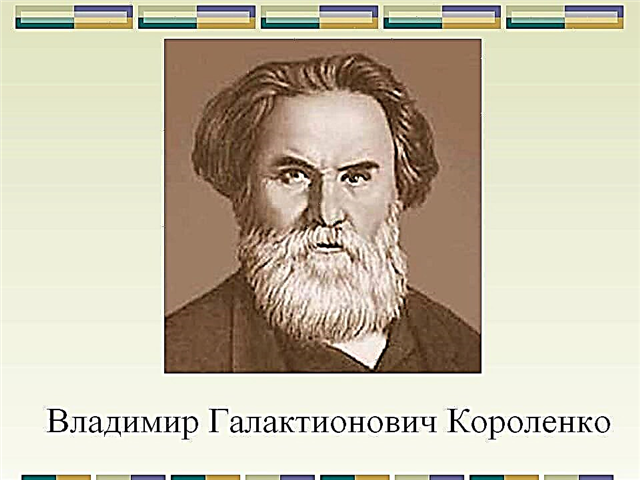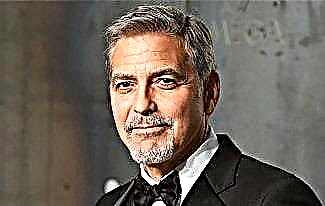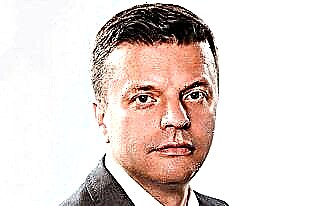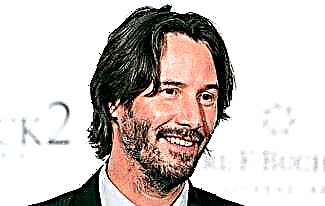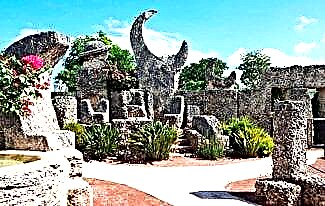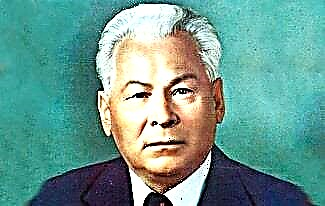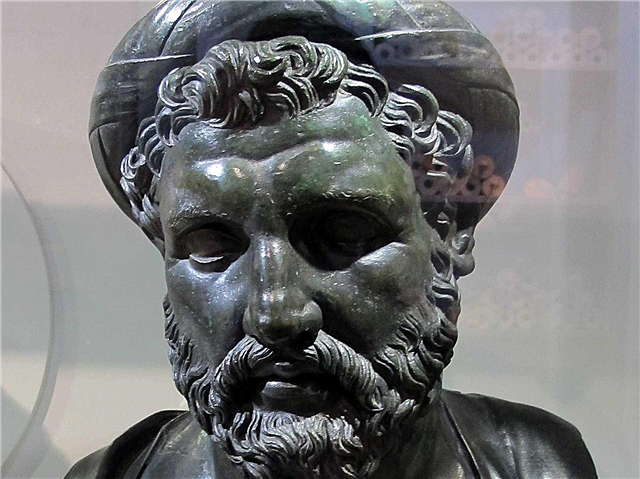Heinrich Luitpold Himmler (1900-1945) - one of the key figures of the Third Reich, the Nazi Party and the Reichsfuehrer SS. He was involved in a number of Nazi crimes, being one of the main organizers of the Holocaust. He directly influenced all internal and external police and security forces, including the Gestapo.
Throughout his life, Himmler was fond of the occult and propagated the racial policy of the Nazis. He introduced esoteric practices into the everyday life of SS soldiers.

It was Himmler who founded death squads, which carried out large-scale murders of civilians. Responsible for the creation of concentration camps in which tens of millions of people were killed.
There are many interesting facts in the biography of Himmler, which we will talk about in this article.
So, before you is a short biography of Heinrich Himmler.
Biography of Himmler
Heinrich Himmler was born on October 7, 1900 in Munich. He grew up and was brought up in a simple family of zealous Catholics.
His father, Joseph Gebhard, was a teacher, and his mother, Anna Maria, was involved in raising children and managing the house. In addition to Heinrich, two more boys were born in the Himmler family - Gebhard and Ernst.
Childhood and youth
As a child, Henry did not have good health, suffering from constant stomach pains and other diseases. In his youth, he devoted time every day to gymnastics to become stronger.
When Himmler was about 10 years old, he began to keep a diary in which he discussed religion, politics and sex. In 1915 he became a Landshut cadet. After 2 years, he was enlisted in the reserve battalion.
When Heinrich was still undergoing training, the First World War (1914-1918) ended, in which Germany was completely defeated. As a result, he never had time to participate in the battles.
At the end of 1918, the guy returned home, where a few months later he entered a college at the agricultural faculty. An interesting fact is that he was fond of agronomy even in the rank of Reichsfuehrer, ordering the prisoners to grow medicinal plants.

At the time of his biography, Heinrich Himmler still considered himself a Catholic, but at the same time felt a particular disgust for Jews. Then in Germany, anti-Semitism was spreading more and more, which could not but rejoice the future Nazi.
It is worth noting that Himmler had many friends of Jewish origin, with whom he was very polite and courteous. At that time, Heinrich struggled to build a military career. When his efforts were unsuccessful, he began to seek friendship with prominent military leaders.
The man managed to get to know Ernst Rem, one of the founders of the Storm Troops (SA). Himmler looked with admiration at Rem, who went through the entire war, and on his recommendation joined the anti-Semitic organization "Society of the Imperial Banner".
Political activity
In mid-1923, Heinrich joined the NSDAP, after which he took an active part in the famous Beer Putsch, when the Nazis tried to carry out a coup. At the time of his biography, he set out to become a politician, seeking to improve the state of affairs in Germany.
However, the failure of the Beer Putsch did not allow Himmler to achieve success on the political Olympus, as a result of which he had to return home to his parents. After a series of failures, he became a nervous, aggressive and detached person.

At the end of 1923, Henry renounced the Catholic faith, after which he deeply studied the occult. He was also interested in German mythology and Nazi ideology.
After Adolf Hitler was imprisoned, he, taking advantage of the turmoil that arose, became close to one of the founders of the NSDAP, Gregor Strasser, who made him his propaganda secretary.
As a result, Himmler did not disappoint his boss. He traveled all over Bavaria, where he urged the Germans to join the Nazi party. While traveling around the country, he observed the miserable situation of people, especially peasants. However, the man was sure that only Jews were the culprits of the devastation.
Heinrich Himmler conducted a thorough analysis regarding the size of the Jewish population, Freemasons and political enemies of the Nazis. In the summer of 1925 he joined the National Socialist German Workers' Party, re-created by Hitler.
After a couple of years, Himmler advised Hitler to form an SS unit, in which there would be exclusively purebred Aryans. Appreciating the talent and ambitions of Heinrich, the party leader made him Deputy Reichsfuehrer SS in early 1929.
SS head
A couple of years after Himmler took office, the number of SS fighters increased by about 10 times. When the Nazi unit gained independence from the Storm Troops, he decided to introduce a black uniform instead of a brown one.
In 1931, Heinrich announced the creation of a secret service - the SD, headed by Heydrich. Many Germans dreamed of joining the SS, but for this they had to meet strict racial standards and possess "Nordic qualities."
A couple of years later, Hitler promoted the SS leader to the rank of Obergruppenführer. Also, the Fuehrer favorably reacted to Himmler's idea of creating a Special Unit (later "Imperial Security Service").

Heinrich concentrated enormous power, as a result of which he became one of the most influential persons in Germany. In 1933 he builds the first concentration camp, Dachau, where initially only political enemies of the Nazis were sent.
Over time, criminals, homeless people and representatives of the "lower" races began to stay in Dachau. On the initiative of Himmler, terrible experiments on people began here, during which thousands of prisoners died.
In the spring of 1934, Goering appointed Himmler to head the Gestapo, the secret police. Heinrich participated in the preparations for the "Night of Long Knives" - the brutal massacre of Adolf Hitler over the SA soldiers, which took place on June 30, 1934. It is worth noting that it was Himmler who falsely testified about the many crimes of the stormtroopers.
The Nazi did this in order to eliminate any possible competitors and gain even greater influence in the country. In the summer of 1936, the Fuehrer appointed Heinrich the supreme head of all services of the German police, which he actually wanted.
Jews and the Gemini project
In May 1940, Himmler formulated a set of rules - "Treatment of other peoples in the East", which he presented to Hitler for consideration. In many respects, with his submission, up to 300,000 Jews, Gypsies and Communists were liquidated the very next year.
The murders of innocent citizens were so massive and inhuman that the psyche of Henry's personnel simply could not stand it.
An interesting fact is that when Himmler was called on to stop the mass extermination of prisoners, he said that this was an order of the Fuehrer and that the Jews are carriers of the communist ideology. After that, he said that everyone who wants to abandon such purges can themselves be in the place of the victims.

By that time, Heinrich Himmler had built about a dozen concentration camps, where thousands of people were killed every day. When German troops occupied various countries, Einsatzgruppen infiltrated the occupied lands and exterminated Jews and other "subhumans".
In the period 1941-1942. about 2.8 million Soviet prisoners died in the camps. During the Second World War (1939-1945), up to 3.3 million Soviet citizens became victims of concentration camps, the overwhelming majority of whom died from executions and being in gas chambers.
In addition to the total destruction of people objectionable to the Third Reich, Himmler continued the practice of medical experiments on prisoners. He led the Gemini project during which Nazi doctors tested medicines on prisoners.
Modern experts believe that the Nazis sought to create a superman. The victims of horrific experiences were often children who either died a martyr's death or remained disabled for the rest of their lives.
The Gemini's accompanying force was the Ahnenerbe Project (1935-1945), an organization founded to study the traditions, history and heritage of the Germanic race.
Its employees traveled around the world, trying to discover artifacts of the ancient power of the Germanic race. Colossal funds were allocated for this project, which allowed its members to have everything they needed for their research.
By the end of the war, Heinrich Himmler set out to conclude a separate peace with his opponents, realizing that Germany was doomed to failure. However, he did not achieve any success in his efforts.
At the end of April 1945, the Fuhrer called him a traitor and ordered him to find Heinrich and destroy him. However, by that time, the head of the SS had already left the territory that was under German control.
Personal life
Himmler was married to a nurse, Margaret von Boden, who was 7 years his senior. Since the girl was a Protestant, Henry's parents were against this marriage.
Nevertheless, in the summer of 1928, the young people got married. In this marriage, the girl Gudrun was born (Gudrun died in 2018 and until the end of her days supported her father and Nazi ideas. She provided various assistance to former SS soldiers and attended neo-Nazi meetings).

Also, Heinrich and Margaret had an adopted son who served in the SS and was in Soviet captivity. When he was released, he worked as a journalist, dying childless.
At the beginning of the war, the relationship between the spouses began to cool down, as a result of which they rather portrayed a loving husband and wife, rather than really were. Soon Himmler had a mistress in the person of his secretary named Hedwig Potthast.
As a result of this relationship, the head of the SS had two illegitimate children - a boy Helge and a girl Nanette Dorothea.
An interesting fact is that Himmler always carried the Bhagavad Gita with him - one of the sacred books in Hinduism. He regarded it as an excellent guide to terror and brutality. With the philosophy of this particular book, he substantiated and justified the Holocaust.
Death
Himmler did not change his principles even after the defeat of Germany. He sought to lead the country after the defeat, but all his attempts have yielded no result. After the final refusal of Reich President Doenitz, he went underground.
Heinrich got rid of his glasses, put on a bandage and, in the uniform of a field gendarmerie officer, headed towards the Danish border with forged documents. On May 21, 1945, near the town of Meinstedt, under the name of Heinrich Hitzinger (similar in appearance and previously shot), Himmler and two like-minded people were detained by former Soviet prisoners of war.
After that, one of the key Nazis was taken to a British camp for further interrogation. Soon, Heinrich confessed who he really was.
During the medical examination, the prisoner bit through a capsule with poison, which was in his mouth all the time. After 15 minutes, the doctor recorded his death. Heinrich Himmler died on 23 May 1945 at the age of 44.
His body was buried in the vicinity of the Luneburg Heath. The exact burial place of the Nazi remains unknown to this day. In 2008, the German newspaper Der Spiegel named Himmler as the architect of the Holocaust and one of the worst mass murderers in human history.
Himmler Photos












